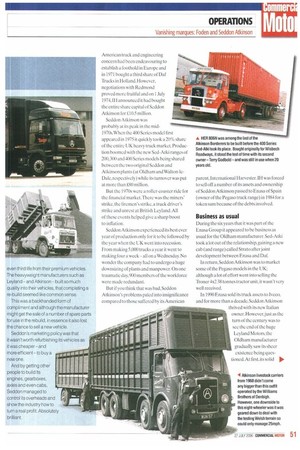It was a case of David meets Goliath, but I'm
Page 50

Page 51

If you've noticed an error in this article please click here to report it so we can fix it.
not sure who was who. When Harry Redmond set his sights on taking over Atkinson Vehicles in 1970, the Atkinson management didn't know whether to laugh or cry. Tony Allen, the then chairman, gave short shrift to this upstart from Oldham it should have been Atkinson taking over Seddon and not vice versa.
In fact, ERF and Foden were also targeting Atkinson at a time when it just wanted to be left alone. Demand for the Atkinson heavyweight product was very high and the business was making a great deal of money. However, once the Allen family had floated the Preston-based manufacturer on the stock exchange (in 1948) they had laid themselves open to the possibility of a takeover bid sometime in the future.
In 1970, competitor Leyland Motors actually held 20% of the Atkinson shares, and it was Leyland's support for the Seddon bid which eventually won the day.
To say the deal went down like a lead balloon is putting it mildly, with bad feeling rife not only with the Atkinson management but also among many on the company's shop floor. Atkinson was the heavyweight manufacturer, which could trace its history back to 1916 and its first steam-powered vehicle.
It was Atkinson that began building eightwheelers (the flagship of many UK hauliers) from 1937 and it was Atkinson that was meeting the demanding needs of such a diverse market-from the extremes of heavy haulage as well as Colonial buyers of old in South Africa, Australia and New Zealand.
It was Atkinson that had all the history and pedigree-so just who did Seddon think it was?
Harry Redmond gave short shrift to the Atkinson protestations and simply proclaimed that in 1970, Seddon was the most profitable independent truck builder in the UK. Not bad from someone who started his business life as an auditor. And when he joined Foster & Seddon in 1926 -the company was simply a dealership selling other people's vehicles. The first four-wheeler to be produced by Foster & Seddon was designed by Robert Seddon and powered by Frank Perkins' newly launched P6 engine.
This prototype, which appeared in October 1938, was soon put on hold, as Foster & Seddon were commandeered by the government to build trailers during the Second World War as part of the war effort.
The pause in proceedings didn't do any long-term harm, as peacetime saw an immediate demand for the new Seddon product. Demand grew so quickly that in 1948 the company moved from its modest premises in Salford to the current Woodstock factory at Shaw near Oldham.
The marketing secret of the early Seddon success was audacious these Saddens were small, light and cheap. They were so cheap many people simply opted to replace an old Seddon when it was worn out rather than consider refurbishing it.
In the 1940s and 1950s, it was common practice for many hauliers to get a second or even third life from their premium vehicles. The heavyweight manufacturers such as Leyland and Atkinson — built so much quaky into their vehicles, that completing a re-build seemed like common sense.
This was a backhanded form of compliment and although the manufacturer might get the sale of a number of spare parts for use In the rebuild, in essence it also lost the chance to sell a new vehicle.
Seddon's marketing policy was that it wasn't worth refurbishing its vehicles as it was cheaper and more efficient—to buy a new one.
And by getting other people to build its engines, gearboxes, axles and even cabs, Seddon managed to control its overheads and show the industry how to turn a real profit. Absolutely brilliant,
























































































































































































